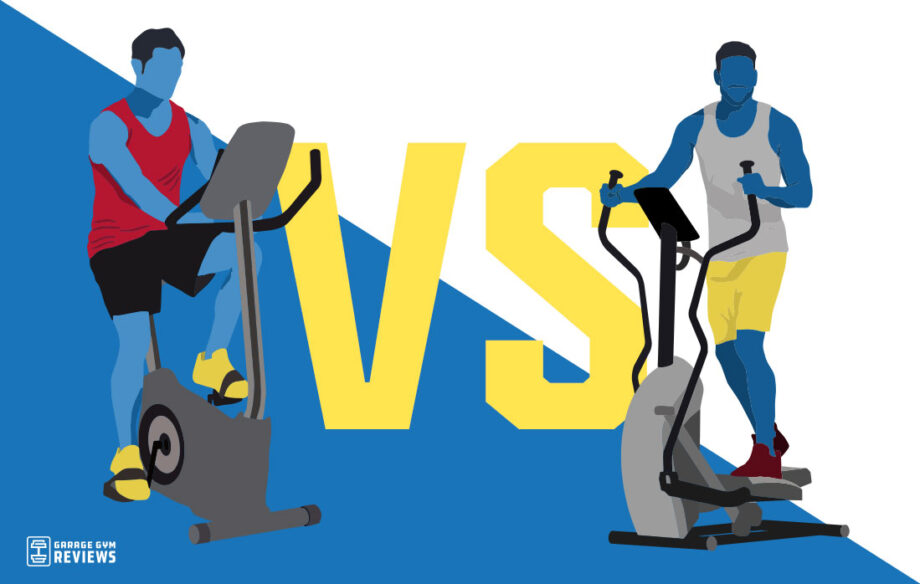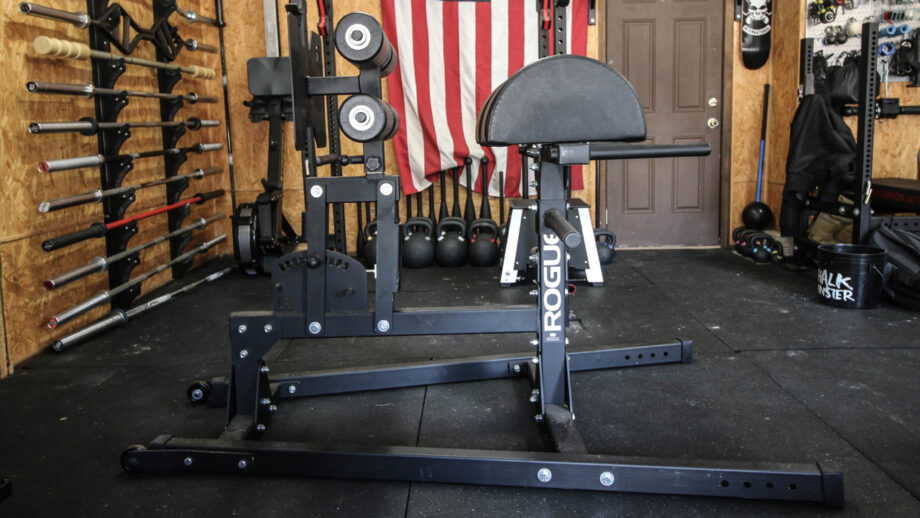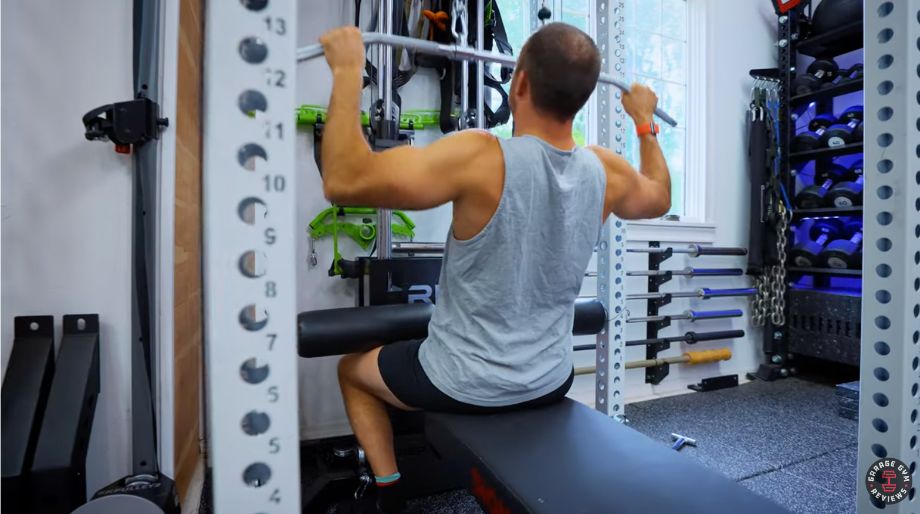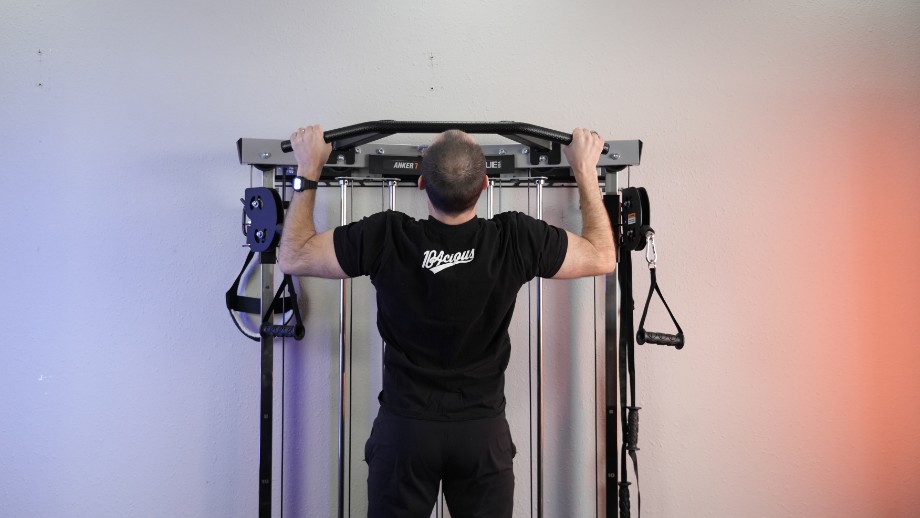Ah yes, the age-old elliptical vs bike debate. Greater men than I have tried to parse this one out, but I promise you the comparison isn’t as daunting as it might seem. Basically, both elliptical machines and stationary bikes are cardio staples, and either would make a great addition to your home gym.
Cardiovascular exercise is an important fitness component, working to improve your lungs, heart, endurance, and overall fitness level. Both of these machines allow for multiple types of cardio, in addition to activating specific muscle groups along the way.
Kate Meier, certified personal trainer and head of content at GGR, notes that having either piece of equipment makes workouts more accessible.
“Getting cardio in at home usually means going for a walk or run, but having a cardio machine in your home gym means you can get your heart rate up at any time, rain or shine,” Meier says.
This guide will help you understand your options to get your cardio in (quite literally) to your heart’s content.
Elliptical vs Bike: Muscles Worked
Both the elliptical and the exercise bike target key muscle groups, though there are a few discernible differences.
Muscles Worked on an Elliptical
The elliptical machine is a good option for providing a full-body cardio workout. According to Meier, the machine accomplishes this by activating your upper and lower body simultaneously.
“Both the elliptical and the bike primarily focus on lower-body muscles: quads, hamstrings, glutes and calves,” Meier says. “However, if the machine has moving handles and you can do a push-pull motion, you’ll also hit your upper back muscles (like the rhomboids and trapezius) as well as the biceps.”
Meier also notes that you use your core on an elliptical.
“There is significant stability required while using an elliptical to keep yourself upright and balanced on the machine,” she says. “Just like running, an elliptical engages your core muscles.”
By ramping up the incline on the machine (if that option is available), you can shift the focus of your workout to hone in on a particular set of muscles such as your calves and hamstrings. Also, the faster you move, the more intensely your muscle groups will be worked.
Muscles Worked on a Stationary Bike
Generally speaking, exercise bikes are known for providing primarily lower body workouts activating muscles like your hamstrings, calves, and quads. You might feel some burn in your glutes as well, although likely not as much as the other lower body muscle groups. If the bike has moving handles, like many air bikes do, you’ll also target some upper body muscles, like those in your back (rhomboids) and arms (biceps and deltoids).
According to Meier, stationary bikes do a good job of working your lower-body muscles in a safe way, which can be helpful for athletes who have recently been hurt.
“Stationary bikes are often useful for people who are rehabilitating an injury because they are incredibly low-impact, taking the weight off your feet and lower-body,” Meier says.
It’s also worth mentioning that by lifting yourself out of the seat during a stationary bike session, you can loop in your core and upper body to give yourself a more comprehensive full-body workout.

Elliptical vs Bike: Space
Space is an important factor when comparing ellipticals vs stationary bikes.
If you’re facing a space constraint in your home gym, be wary of purchasing an elliptical, as they’ll almost always take up more room than your standard exercise bike. For context, the length of a stationary bike is usually in the range of 40 to 60 inches, while the typical length of an elliptical can be anywhere from 50 to 80 inches. By nature, a stationary bike is a more compact machine and has a smaller footprint, although of course there are exceptions.
RELATED: Best Compact Elliptical
When considering adding either of these to your home gym, it can be helpful to leave some extra space surrounding the machine. Even though both pieces of equipment are stationary, the additional room can help ensure there are no issues with getting yourself on or off the machine.
Elliptical vs Bike: Adjustability
One perk both of these machines share is that they can be adjusted to fit each user’s needs. A stationary bike often offers seat, handlebar, and even pedal adjustments to give you the most comfortable ride possible. You’ll also be able to change the resistance level of the machine to give yourself a higher-intensity workout if you so desire.
The level of adjustability for ellipticals varies more from machine to machine. With most ellipticals, the faster you move, the more difficult your workout will be. Some models allow the user to change resistance and incline as well. On the high end, there are even ellipticals that enable you to adjust the stride length.
However, there’s often not much you can do to alter the elliptical setup to fit people of different heights. It’s more of a one-size-fits-all machine, so be certain that your arms and legs are totally secure before beginning your workout.

Elliptical vs Bike: Calories Burned
First and foremost, both machines will give you the opportunity to burn calories during your cardio workout. How fast you burn calories depends on both the intensity of your workout and the duration, along with several other factors.
To put things in perspective, a study from Harvard Health Publishing examined the number of calories burned by a 125-pound person, a 155-pound person, and a 185-pound person during 30 minutes of moderate exertion on numerous gym machines. The findings for the stationary bike and the elliptical were as follows:
| 125-pound person | 155-pound person | 185-pound person | |
| Stationary Bike | 210 calories burned | 252 calories burned | 294 calories burned |
| Elliptical | 270 calories burned | 324 calories burned | 378 calories burned |
As you can see, both machines can be effective in burning calories and there are numerous ways to go about doing so. However, the elliptical has a slight edge here since it offers a more full-body workout experience, allowing the user to burn calories quicker during standard workouts.

What Is a Stationary Bike?
A stationary bike, often generally referred to as an exercise bike, is a low-impact cardio machine (compared to a high-impact cardio option like a treadmill) that imitates the motion of riding a moving bicycle. During use, the user will lock their feet into the pedals, grab the handlebars and make the same pedaling motion as if they were riding a bicycle outdoors.
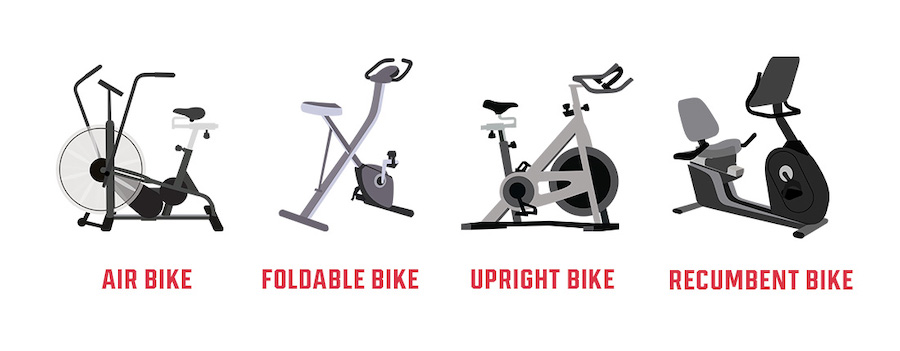
If you’re looking to purchase a stationary bike for your home gym, there are numerous options, with the price range spanning anywhere from around $200 to over $2,000. As with any piece of exercise equipment, you’ll pay more for the higher-end options, so make sure you have a budget in mind before you buy.
The best exercise bikes offer many different types of cardio workouts, mainly focused on the lower body, although it’s possible for users to raise themselves out of the seat while pedaling to engage their upper bodies as well.
Stationary bikes can also be adjusted to fit the user’s needs, with different seat, handlebar, and pedal adjustments often available. Usually, you’ll be able to kick up the bike’s resistance during use to offer a more intense workout if that’s what you’re after.
The size of your exercise bike will of course depend on the model you choose, but you can likely expect the machine to have a width of around 20 to 25 inches, a height of around 50 to 60 inches, and a length of around 40 to 60 inches. We recommend taking stock of the space you have available in your garage gym before buying to avoid overcrowding the space.
RELATED: Recumbent Bike Vs Upright Bike
Best For
The stationary bike is a good option for anyone looking for a stable, low-impact workout, specifically one focused on the lower body. Since you have the option to sit during use, those struggling with mobility or knee/joint pain or recovering from injury might also benefit from using the machine since it can support your body weight and take some of the stress off your joints.
Also, if you have a lower budget and a limited amount of space for a cardio machine in your home gym, it might be wise to consider going with a stationary bike. They’re often the cheaper and more compact option when compared to an elliptical.
If you’re looking for a safe, stable way to get your heart rate up with a lower body-focused cardio workout, the stationary bike could be the machine for you.
| Exercise Bike Pros | Exercise Bike Cons |
|---|---|
| Low-impact | More difficult to involve upper body |
| Stable | Seat can get uncomfortable |
| Budget-friendly options available | Can be noisy, especially with air bikes |
| Good for those recovering from injury | Chains require maintenance |
| Improves cardiovascular endurance, burns calories, strengthens muscles |
Pros
There are many benefits of stationary bikes, one of which is that they offer a low-impact form of cardio. Because your feet stay clipped into the pedals throughout the duration of the workout, your joints won’t be overly strained while you work out. Think of it as competing in the Tour de France without the wear and tear of pedaling through the French countryside.
Stationary bikes allow you to accomplish a lot all at once; using this machine can strengthen your lower-body muscles, improve your cardiovascular health and endurance, help you burn calories, and reduce your stress levels. What’s not to love?
It’s also pretty easy to switch speeds on a stationary bike, making it a solid option for a HIIT bike workout (high intensity interval training). It’s been found that this kind of workout can be effective in burning calories and fat.
Stationary bikes are also helpful for people with knee pain or joint troubles because the user will likely be sitting down for the duration of the workout. You won’t have to put as much weight on your joints, allowing you to get in some healthy and safe cardio exercise.
RELATED: 9 Benefits Of Indoor Cycling

Cons
One complaint some people have about using a stationary bike is that sitting on the bike seat for an extended period of time can get uncomfortable. Aftermarket options like padded bike shorts can help mitigate this discomfort, but it’s something we think you should be aware of.
Also, the stationary bike mainly works the lower body, offering limited opportunities to target other muscle groups. It’s great for focusing on muscles like your quads and glutes, but you might consider choosing a different machine if you’re seeking something designed for a full-body workout (though it’s possible to engage your upper body by lifting yourself out of the seat as you pedal).
If you want a bike that incorporates more upper-body work, you might consider an air bike. Many of these bikes, which use air as resistance, feature moving handles that engage muscles including the upper back and biceps.
What Is an Elliptical?
An elliptical is a low-impact cardio machine meant to simulate the movements of walking, running, and stair climbing, at least to some degree. Users will place their feet on the pedals, grab onto the handles and move both simultaneously during use, creating a full-body workout.
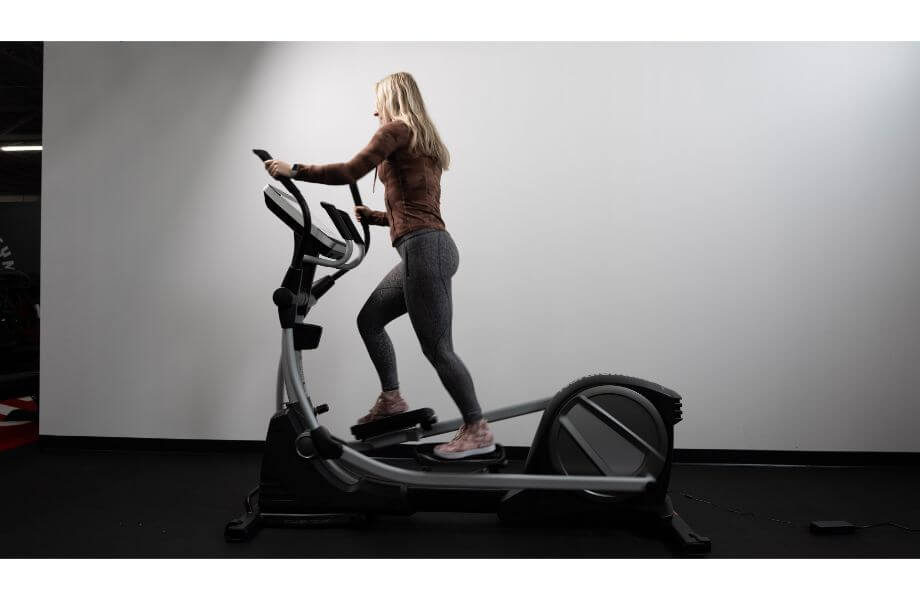
As such, an elliptical machine will work lower body muscles like the quads and calves while also engaging upper body groups like your core and arms. Both HIIT elliptical workouts and more endurance-based workouts are possible, depending on how fast you choose to stride and how long you want the session to last.
RELATED: How to Choose an Exercise Bike
Ellipticals are generally higher-priced than stationary bikes, running anywhere from around $600 to well over $2,000 (with a few higher-end models straying above $3,000). If you’re thinking of purchasing one, make sure to consider your options carefully to avoid breaking the bank.
Elliptical trainers usually take up more space than a stationary bike, with lengths stretching anywhere from 50-80 inches. Also, the pedals and handles on the machine promote both lateral and vertical movement, so it’s advisable to leave yourself a little extra space on all sides of the machine when setting it up.
RELATED: Rowing Machine Vs. Elliptical
Best For
Ellipticals work the best for people looking for a low-impact, full-body cardio workout. Also, it helps if you have no issues stepping up onto the pedals, as this motion will likely be required in order to use the machine.
Beginners or athletes still looking to find their form might also benefit from using the elliptical; since the handles and pedals move in tandem, the machine provides a sort of safety net preventing your technique from getting out of whack. You can just strap in and let the machine guide you through the workout.
An elliptical machine could suit your home gym nicely if you have a relatively large space to put the machine and a budget of at least $500-$600. There are decent budget ellipticals available, though most quality ones will fall around $300-$500. In addition, make sure you have an outlet nearby, as ellipticals require a power source in order to function.
| Elliptical Pros | Elliptical Cons |
|---|---|
| Full-body workout | Can be more expensive than bikes |
| Low-impact | Limited height and size adjustability |
| May offer incline/resistance adjustments | Often requires power source |
| Great for any fitness level | Large footprint |
| Improves cardiovascular endurance, burns calories, strengthens muscles | Could be troublesome for those with stability issues |
Pros
Just like the stationary bike, elliptical workouts are inherently low-impact and avoid putting excess pressure on your joints. Your feet stay connected to the pedals the entire time, moving with the machine in a smooth gliding motion.
The elliptical also has a slight advantage over the stationary bike in that it does a better job of getting your upper body involved over the course of a workout. Since the machine requires you to grab onto the handles during use and move them as you pedal, it works your upper body and lower body at the same time.
Furthermore, the elliptical machine can sometimes be adjusted to offer differing levels of resistance or to focus on specific parts of the body and muscle groups. This versatility can help provide a balanced workout.
RELATED: NordicTrack SE9i Review
Cons
Because of its unique shape and range of motion, the elliptical machine isn’t something that closely mimics any common real-life movement.
If you live in a small space, the elliptical may not be the way to go for cardio unless you find a compact machine. Typically, ellipticals take up a decent amount of space, and it’s rare to find one that folds and can be stowed away.
It’s also worth noting that due the way ellipticals are constructed, the user often has to step upward in some capacity to reach the pedals. For people with mobility or stability issues, this could make the machine more difficult to use.
Lastly, ellipticals tend to be costlier than exercise bikes. It’s possible to find budget-friendly options, but because they have more working parts than bikes, the price tag is often a little higher.
Bottom Line
Both the elliptical and the stationary bike are tried and true cardio machines. Furthermore, they can provide health benefits of all kinds, according to Meier.
“Either machine is great for a range of benefits, including physical and mental health perks. Physically, you can burn calories, build cardiovascular endurance, and strengthen muscles,” Meier says. “Mentally, studies suggest that exercise in general is useful in fighting anxiety, stress, and even depression.”
I think one of the most important things to remember when considering the bike vs elliptical debate is that one isn’t necessarily better than the other. Rather, people might be better suited for one machine over the other based on their fitness goals, fitness level, budget, space constraints, and numerous other factors.
Elliptical vs Bike FAQs
Is an elliptical better exercise than a stationary bike?
The short answer here is that neither machine is inherently better than the other. The elliptical will suit some people better, while the stationary bike will work better for others depending on your fitness goals, body type, and level of mobility.
Is a bike or elliptical better for weight loss?
Both stationary bikes and ellipticals can be used to burn calories, which can then lead to weight loss. Utilizing HIIT workouts is a proven way to burn calories, and such workouts can be executed well on either machine.
Which exercise machine is best for losing belly fat?
Neither machine is inherently better for losing fat. Both machines allow the user to burn calories during cardio workouts, which can lead to weight and fat loss. The number of calories burned depends on factors like the duration and intensity of your workout.
Is a stationary bike better for your quads than an elliptical?
Both ellipticals and stationary bikes target your lower body muscle groups, including your quadriceps. It all depends on how you choose to use the machine, but both can allow you to activate your quads during your workout.
Is an elliptical or a stationary bike better for bad knees?
An exercise bike is the better option for people with bad knees because there’s less impact on your joints. Elliptical machines are still a better choice than a treadmill for such people.


